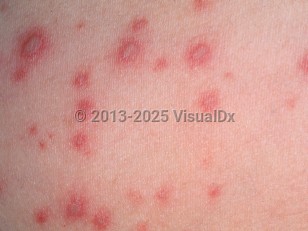Potentially life-threatening emergency
Neonatal varicella
Alerts and Notices
Important News & Links
Synopsis

This summary discusses varicella in neonates. Varicella in adults and children is addressed separately.
Neonatal varicella, or neonatal chickenpox, is infection with varicella-zoster virus (VZV) during the first 4-6 weeks of life. Neonates may be infected (1) in utero by transplacental viremia, (2) at birth by ascending infection, or (3) after birth by respiratory droplets or direct contact with infectious lesions. The incubation period of VZV is usually between 10 and 14 days; therefore, onset of symptoms within the first 10 days of life is usually caused by intrauterine transmission. Onset of symptoms after 10 days is usually indicative of postnatally acquired infection.
Intrauterine-acquired neonatal varicella is common in infants born to birthing parents who contract a primary varicella infection during the last 3 weeks of pregnancy. The severity of neonatal disease is dependent on the presence of transplacentally acquired antibodies from the birthing parent. Hence, onset of the rash of primary VZV infection in the birthing parent between 6 and 21 days prior to delivery allows for antibody production, transplacental transfer to the fetus, and nonfatal neonatal varicella. Conversely, onset of rash in the birthing parent between 5 days before and 2 days after delivery does not allow sufficient time for antibody production, and one can expect a fulminant course.
Postnatally acquired VZV infections are usually self-limited in healthy full-term infants. However, severe varicella may result in neonates less than 28 weeks' gestation or below 1000 grams at birth.
Neonatal varicella, or neonatal chickenpox, is infection with varicella-zoster virus (VZV) during the first 4-6 weeks of life. Neonates may be infected (1) in utero by transplacental viremia, (2) at birth by ascending infection, or (3) after birth by respiratory droplets or direct contact with infectious lesions. The incubation period of VZV is usually between 10 and 14 days; therefore, onset of symptoms within the first 10 days of life is usually caused by intrauterine transmission. Onset of symptoms after 10 days is usually indicative of postnatally acquired infection.
Intrauterine-acquired neonatal varicella is common in infants born to birthing parents who contract a primary varicella infection during the last 3 weeks of pregnancy. The severity of neonatal disease is dependent on the presence of transplacentally acquired antibodies from the birthing parent. Hence, onset of the rash of primary VZV infection in the birthing parent between 6 and 21 days prior to delivery allows for antibody production, transplacental transfer to the fetus, and nonfatal neonatal varicella. Conversely, onset of rash in the birthing parent between 5 days before and 2 days after delivery does not allow sufficient time for antibody production, and one can expect a fulminant course.
Postnatally acquired VZV infections are usually self-limited in healthy full-term infants. However, severe varicella may result in neonates less than 28 weeks' gestation or below 1000 grams at birth.
Codes
ICD10CM:
B01.9 – Varicella without complication
P35.8 – Other congenital viral diseases
SNOMEDCT:
240469009 – Perinatal varicella
B01.9 – Varicella without complication
P35.8 – Other congenital viral diseases
SNOMEDCT:
240469009 – Perinatal varicella
Look For
Subscription Required
Diagnostic Pearls
Subscription Required
Differential Diagnosis & Pitfalls

To perform a comparison, select diagnoses from the classic differential
Subscription Required
Best Tests
Subscription Required
Management Pearls
Subscription Required
Therapy
Subscription Required
References
Subscription Required
Last Reviewed:05/12/2025
Last Updated:05/13/2025
Last Updated:05/13/2025
Potentially life-threatening emergency
Neonatal varicella

